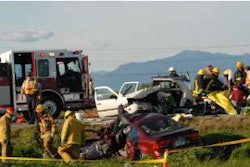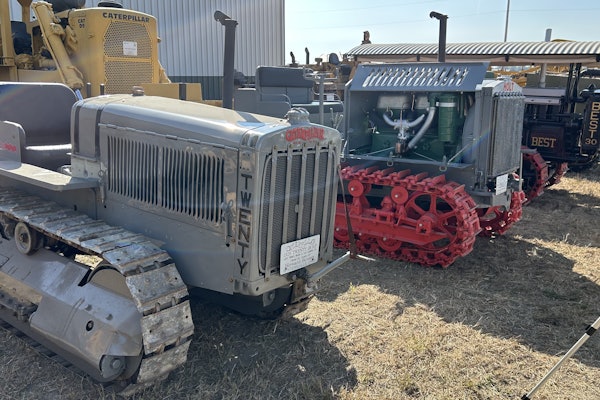Customer feedback programs allow operators to play a larger role in equipment design and evolution.
After Gregg Perrett, owner and president of Valentine, Neb.-based Perrett Construction, tried for at least a year to give input to manufacturers about his experience operating their equipment — but to no avail — his opportunity finally arrived.
 The store manager at Murphy Tractor in Nebraska, the dealership where Perrett is a customer, had given his name to Deere corporate when the manufacturer asked the dealership who would be good to be part of a group to provide input. Perrett was more than happy to oblige.
The store manager at Murphy Tractor in Nebraska, the dealership where Perrett is a customer, had given his name to Deere corporate when the manufacturer asked the dealership who would be good to be part of a group to provide input. Perrett was more than happy to oblige.
“I had tried for over a year to give input for other brands, but I felt like no one was receptive,” Perrett says. “I was excited to be part of this.”
 Perrett met with a group in the Phoenix area and then several times in Iowa. The group provided input on equipment for nearly two years, providing significant feedback for Deere’s G-Series motor graders.
Perrett met with a group in the Phoenix area and then several times in Iowa. The group provided input on equipment for nearly two years, providing significant feedback for Deere’s G-Series motor graders.
He says the focus group provided feefback on visibility, blades, side compartments, doors, panels, the longevity of hinges, cooling systems, how a ripper blade worked on the back of a machine, weight ratios, grade control, and fingertip controls for steering, among other current and proposed options.
 “We provided a lot of input,” Perrett says, adding that his team of operator reviewers spent substantial time assisting Deere with fine-tuning slope control on a motor grader in a field south of Phoenix.
“We provided a lot of input,” Perrett says, adding that his team of operator reviewers spent substantial time assisting Deere with fine-tuning slope control on a motor grader in a field south of Phoenix.
Perrett’s comments proved to be valuable. He doesn’t own a G-Series motor grader, but the manufacturer had him demo a  prototype for several months. Data collected during this time was especially notable because Perrett was operating the machine without any preconceived expectations, and that allowed him to offer noteworthy feedback that influenced the final design of the G Series prototype.
prototype for several months. Data collected during this time was especially notable because Perrett was operating the machine without any preconceived expectations, and that allowed him to offer noteworthy feedback that influenced the final design of the G Series prototype.
“The fingertip steering was on the wrong side,” Perrett points out. “If you went to shift, the lever to control the steering and the steering wheel were [not in the right location]. You couldn’t shift and steer at the same time.”
Perrett’s input was used in the decision to move the fingertip steering to the left side of the machine. “We looked at a lot of little things like this,” Perrett says, noting that it’s often the “little things” that really matter when making a decision to buy or rent a particular machine. Visibility, machine control, and monitor placement are also some of those “little things,” Perrett says. “We worked a lot on that. We also worked on the machine control monitor and placement.”
The previous location of the monitor affected visibility, Perrett says. “But after working on it, we all agreed the monitor should be put above the steering wheel in the middle of the console,” he says. “We all had a sense of accomplishment. When you get manufacturers that come out and talk to the actual people who are running the machines to try to make them better, it really means a lot.”
A ‘Chatterbox’ of information
John Deere also uses its “Chatterbox” mobile recording studio, which the company introduced at ConExpo-Con/Agg 2011. The “box” is a trailer taken to job sites around the country. It is equipped with a small conference area, a video camera set-up similar to a small television studio, a refrigerator, and a recliner that comes complete with a machine joystick to add to operators’ comfort during the videotaped session where participants can sit back and answer pre-programmed questions and see their image on a screen. Categories for the user feedback change based on how a customer answers questions and based on the geographic location where the Chatterbox is taken. Deere says this system is how the company is able to give equipment operators a greater voice within Deere and throughout the industry and often provides provocative answers. (To see a YouTube video of first-time encounters with the Chatterbox, go to http://www.events.deere.com/youreon/chatterbox/.) Equipment operators are also able to submit comments at any time via the Chatterbox website at http://www.events.deere.com/youreon/mytake/. A monitoring system is in place so Deere is able to follow up with equipment operators, with both positive and negative comments, some of which ultimately lead to improvements to the machines.
‘They’re listening to us’
Case Construction Equipment has used its own set of operator “experts” to develop its Case N Series loader/backhoes. During the 18 months preceding the product line’s September 2010 introduction, Case enlisted operators from the United States and Canada to review equipment  designs and test pre-production models of the new loader/backhoes in various applications and climate conditions. Dennis Zenter, owner of DRZ Contracting Ltd. in Delta, B.C., Canada, was one of six operators from North America asked to help evaluate the Case N Series. In the original prototype design, Zenter says his comments and those of the other evaluators were taken to heart. In the first iteration, a plunger-type piece on the rear window was about 6 inches around and detracted from visibility, Zenter says. He made it clear that it wasn’t a desirable feature. “From the original visit to the second visit, it was made smaller,” Zenter says. There is now a latch there, similar to a pocket and stud, which solved the problem. “I thought, ‘Great! They are actually listening to us!’”
designs and test pre-production models of the new loader/backhoes in various applications and climate conditions. Dennis Zenter, owner of DRZ Contracting Ltd. in Delta, B.C., Canada, was one of six operators from North America asked to help evaluate the Case N Series. In the original prototype design, Zenter says his comments and those of the other evaluators were taken to heart. In the first iteration, a plunger-type piece on the rear window was about 6 inches around and detracted from visibility, Zenter says. He made it clear that it wasn’t a desirable feature. “From the original visit to the second visit, it was made smaller,” Zenter says. There is now a latch there, similar to a pocket and stud, which solved the problem. “I thought, ‘Great! They are actually listening to us!’”
As an owner and operator, Zenter says he is pleased that Case called operators in for the design critique: “Usually, a manufacturer builds the machine, puts it out in the marketplace, and says, ‘What do you think?’ We don’t get to have input. To be included in the process was top-notch. We suggested changes, and [Case] did its best to accommodate them.”
Zenter and other evaluators also reiterated the importance of operator comfort and safety since the equipment is “the office” for operators. After noting that previous models became quite hot when working in the sun, Zenter says he was pleased that Case listened and made opening the rear window of the cab available as an option. Not only does this allow for better circulation, it makes operating the equipment safer. “It was a hot cab in the sunshine, but now you can open up the window in the back and get in some air,” Zenter says. “It’s more comfortable. It [also] allows for better communication with the crew.”
 With the previous model — the M Series — Zenter says his crew had to walk between where the boom swings and the cab, a prime spot for injury. Now they can come up to the side of the machine instead. “There is better visibility from the cab and better airflow,” Zenter says. “The new cab windows are a good safety feature. You can talk with someone without having to walk around the machine.”
With the previous model — the M Series — Zenter says his crew had to walk between where the boom swings and the cab, a prime spot for injury. Now they can come up to the side of the machine instead. “There is better visibility from the cab and better airflow,” Zenter says. “The new cab windows are a good safety feature. You can talk with someone without having to walk around the machine.”
Adding a full-rotation linkage based on operator comments has also enhanced safety for users as well as increasing productivity, Zenter says. “The bucket opens wider and closes tighter,” he says. “When you roll the bucket all the way open to dig, you just have to press a button. Before, there was a manual setting where the operator had to get out and switch a pin. We are constantly changing the position of the bucket. Most operators in the old machine would set the pin at one setting and never change it. The new full rotation solves the problem of having to change the pins all the time.”
The heavy-lift function on the N Series backhoe was also developed using operator experts. The function allows the operator to idle the engine down so it’s quiet enough to talk to someone outside. Zenter says he was skeptical about the function at first. “I thought there was no way it was going to work, but I’ve found it is way safer for lifting and lowering heavy components,” he says. “It is smoother and has more control. When the heavy-lift switch is activated, it goes from about 2,450 rpm to about 1,400 rpm. The lower rpm makes the machine not nearly as jerky.”
 Deere: We want the bad news first
Deere: We want the bad news first
Case brought a machine to Zenter’s operation where he tested it for about two months. Every day, he noted comments for whatever function he used that day. He also filled out a weekly report. The test machine also had video cameras on board so the Case team was able to see how it was being operated in Zenter’s geographic area. The same was done with the other operator testers, which provided Case with data on the West Coast, the Central U.S., and Canada.
“This allowed them [Case] to learn the needs of Canada versus Texas, Florida, Chicago, etc.,” he says. “Within an hour of my house, there are about 15 different types of earth conditions. One day I can be in river sand, and another day I might be in hard shale or might need a blaster to come out.”
Jordan Hess, an equipment operator with Hess Excavation in Coon Valley, Wis., also tested out equipment for Case; he provided feedback on the 580N with pilot controls and standard controls. “I had an awesome time in the program,” Hess says. “It is really neat to sit down with a room full of equipment engineers who wanted to hear what we thought. They wanted to hear everything I had to say and took it to heart. They didn’t want to hear what was good, but what we wanted to change.”
Hess says it’s frustrating when suggestions about equipment are made to the dealer, but “you don’t see any progress with the next generation of the machine.” However, Hess says all of his suggestions were considered. Case either “replaced or tried something different” when Hess noted that particular features could be improved.
Hess, who has a background in equipment maintenance, says one of the first changes he suggested was the nylon sock casing for hydraulic hoses. All of the hoses were put together in one protective nylon sock. Having the hoses all clumped together in one nylon sock makes it difficult and time consuming to just pull out a single hose and work on it or switch it out, Hess says. “I suggested they put each hose in its own individual sock, otherwise you end up pulling out all of the socks,” he says. “In a small business, it’s really important to eliminate this kind of downtime.” The very next time Hess tested the machine, each of the hoses had been placed in its own sock. “I hope when a random person goes to buy a machine, they will be able to tell an actual operator helped to design it,” he says. “Sometimes when I’ve worked on a machine, it just doesn’t make sense the way certain parts of it are put together. It’s great that issues are able to be corrected before they go on the market instead of trying to catch up with what people want.”
To get an even better understanding of what operators want, Hess was asked to wear a hat with special video cameras that tracked his retinas and watched how he used his hands to operate controls while in the machine cab. The footage from the video cameras identified where Hess’ blind spots were and his visibility from where he was sitting in the cab. “It is really neat to know I am making a difference in the future of the backhoe,” he says.
A convenience or inconvenience?
Arden Lemke, owner of Lemke Digging and Geothermal Drilling in Mitchell, S.D., played a role in providing input for Bobcat’s E32/E35 extendable arm. Like Hess, Lemke says having input on the design of the very machine he operates regularly made him feel like he really could influence the manufacturer with his needs. “I was pretty impressed [Bobcat] wanted my opinion, especially because I’m a really small contractor,” Lemke says. “It was pretty outstanding to have them think I had an opinion.”
Lemke began testing Bobcat’s extendable arm for the E32/E35 in September/October 2010, before it went to market. He then bought the mini excavator with the extendable arm in March 2011.
When Bobcat asked Lemke about his opinion on the “extendahoe,” as he refers to it, he was quick to point out that the extendable arm needs to work in very tight quarters and that it needs to have a minimal amount of maintenance. “After they [Bobcat] brought the demonstrator (prototype) on the jobsite and asked my opinion, they followed through on all of my suggestions,” Lemke says. With Lemke’s critiques, the extendable arm can now reach in tight spots where tractor backhoes can’t. “It now has more capability to reach in spots where bigger machines can’t,” he says, adding that it also makes the work area not so tight for employees.
Lemke also provided input on the quick-change attachments, which in his opinion, were anything but that. “It wasn’t really a quick change,” he says. “It was more of an inconvenience change.” Instead of having to exit the cab and take time to change the attachments — which were designed to be easily switched out — now the operator can sit inside of the machine and push a button to change out attachments. “Now, they have it where we can just pull some keys so the pins move,” he says. “There are locking pins to make sure you don’t accidentally activate the X-Change.”
Now, Lemke says, even his newer employees are able to switch out attachments, a job that was reserved for more experienced operators. In Lemke’s three-person operation, this is crucial to his productivity, because downtime means money isn’t being made. “Bobcat understood this and really put a lot of thought into the mini excavators,” Lemke says. This, Lemke says, has just added to what he thinks of the manufacturer: “I am pretty impressed with them.”
Manufacturer Perspective
 To read about how companies are leveraging customer feedback, enter http://www.gettag.mobi into your smart phone browser and download the free app. Then scan this tag for insights from Bobcat, John Deere, Case Construction Equipment, and Terex Minerals Processing Systems.
To read about how companies are leveraging customer feedback, enter http://www.gettag.mobi into your smart phone browser and download the free app. Then scan this tag for insights from Bobcat, John Deere, Case Construction Equipment, and Terex Minerals Processing Systems.
Case: Customer driven designs
When Case Construction Equipment was designing its Alpha Series, the manufacturer wanted to make sure it was developed not just for the customer, but by the customer.
 When Case was designing its Alpha Series, the company interviewed operators to compile nearly 1,500 customers inputs through its Customer Driven Product Development program.
When Case was designing its Alpha Series, the company interviewed operators to compile nearly 1,500 customers inputs through its Customer Driven Product Development program.
Michael J. Unrein, senior director of product marketing for Case-New Holland Construction Equipment, says the company interviewed operators to compile at least 1,500 customer inputs through its Customer Driven Product Development (CDPD) program.
Engineering, marketing, and sales all took part in interviewing the operators, Unrein says. Involving all of these different teams was important, he says, because each segment hears it differently. When all of the input is compiled, it is then used to write a product definition.
Once the product definition is written, customer requirements — essentially, what applications customers want to be able to do with the machines — are developed. It’s then that the engineering team goes to work to design a product that meets customer requirements and address the “pains” of an operator, Unrein explains.
For example, if customers say they want more room in the cab so they are able to get in and out of it more easily and increase their comfort level — engineering tries to figure out a way to work this into the design while meeting the other requirements that were determined as necessary.
This concept was used in adding visibility to the machine while still maintaining its durability. “Customers said they wanted increased visibility, and for them, more glass means increased visibility and safety,” Unrein says. “Case addressed this request by increasing the size of the front and rear glass.” For customers, he says, this means the machine will allow them “to get the job done safely in an often compact environment.”
Terex: Designs by the customer, for the customer
At Terex Minerals Processing Systems, customer input is a requirement on all new product development projects, says Ed Sauser, a product manager for the company.
Terex uses a formal five-phase New Product & Process Development (NPDD) process, which requires customer input for establishing the project goals and project specifications, Sauer explains.
Voice of the customer input is gathered through various means. Sauser says he has personally interviewed customers, gathered information from regional sales managers, used questionnaires with dealers, engaged in question/answer sessions with service training schools and sales events with dealers, and tracked information gathered by trade publications.
“I get a list of recommended customers from our sales team that it feels are experts on the subject,” Sauser says. The feedback is then noted and used to redesign machines and add new features “as is required by our formal NPDD process.”
Features frequently requested include equipment that is low maintenance, easy to operate and maintain, reliable, and safe. “For our portable products, quick set-up is key,” Sauser says, “anything to reduce non-production cost and labor — for example, adding hydraulic clearing functions on crushers so they can be restarted if the equipment becomes stalled.
“In today’s environment, you really need to be customer driven and design equipment around what customers want,” he says. “In past years for companies, there was more of the mindset, ‘This is our product. Let’s go sell it, and you can take it or leave it.’ Now you need to be customer driven and design equipment the way operators want it.”
Bobcat: Hearing their voices
Greg Rostberg, a marketing manager for Bobcat, says using voice of customer, or VOC as Bobcat refers to it, is integral to machine development and redesign. There is the formal VOC process, but, often, the data collection is informal. Marketing managers, product managers, and engineers will go out in the field to see how customers are using a particular machine in an operation and in particular applications. “Depending on what size machine Bobcat will be working on next, we will talk to those customers,” Rostberg says. “We see not only how they are using it in an operation, but we also go to competitive customers and find out why they bought that machine over another one.”
 Rostberg says Bobcat sometimes uses this information as a benchmark. “If we see a solution that a competitive customer has on the machine and likes, we may create the same type of solution,” he says.
Rostberg says Bobcat sometimes uses this information as a benchmark. “If we see a solution that a competitive customer has on the machine and likes, we may create the same type of solution,” he says.
However, if Bobcat and a competitive machine are both lacking something a customer wants, Rostberg says a mule solution is made — i.e. prototyped. “We really value our customers’ opinions,” he says. One of the company’s extendable arm customers continued to voice that a clamp-ready extendable arm was needed. “He kept saying that’s what he wanted,” Rostberg says. “When we converted to the M Series, we held off with an extendable arm for about a year until we could redesign it and could bring him a mule. We then had him test it out. If it’s not the mule the customer expected, then we go back to the drawing board. We may make minor changes or completely redo it before we take the product to market.”
Rostberg says Bobcat also uses tradeshows as a platform for gathering customer input. It’s informal, and many of the product managers and service and parts people are present, he says. “If customers have a service issue, we’ll try to help solve their problem,” Rostberg tells an Aggregates Manager editor at World of Concrete 2012.
When the market declined, Rostberg says Bobcat determined that tradeshows were more important than ever. “We decided shows were too valuable — they are a great way to get feedback,” he says. “They can go through the dealer, but it helps to talk directly to the manufacturer.”













